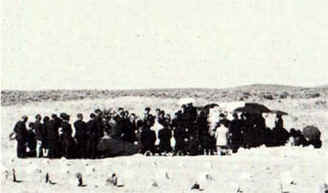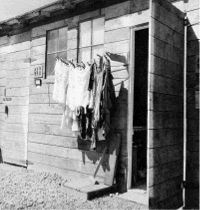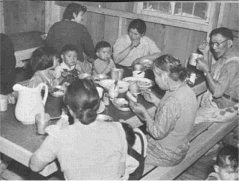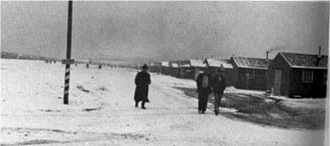
|
Japanese
American Internment Experiences
|

|
| Many other Japanese Americans had difficulty in adjusting to life after internment and some were not able to endure mass imprisonment. Sadly, some elderly prisoners never left having had succumbed to the dehumanizing conditions. |
 Conrat, Executive Order 9066, pg.95 Funeral in Minidoka Relocation Center |
"Many
of those who died in Topaz were buried in the desert, and it seemed a
bitter irony that only then were they outside the barbed wire
fence." (Uchida Desert Exile 134.)
Moreover, the U.S. government put the internees in to a difficult
situation by asking them to declare loyalty to the United States and
renounce their ties to Japan in the loyalty questionnaire circulated in 1943. More.
|
| Those
who were considered disloyal were segregated at Tule Lake. More.
Before Japanese Americans were confined in remote internment camps, they were moved into assembly centers from March until August of 1942. According to Eric Yamamoto’s Race, Rights and Reparation , Japanese Americans were temporarily sequestered at large racetracks and fairgrounds (199). They endured filth, open sewage and inadequate food. |

Hosokawa, Nisei, pg.33 Tanforan Racetrack near San Francisco (National Archives) |
 Conrat, Executive Order 9066, pg86 Tanforan Assembly Center |
In all, ten internment camps were established: Manzanar, Colorado River, Tule Lake, Gila River, Minidoka, Heart Mountain, Granada, Central Utah, Rohwer and Jerome. Once Japanese Americans were forced into internment camps, the conditions were no better. According to Yamamoto, Japanese Americans were ensconced in spartan barracks that held four to six rooms and were forced to trudge out into the elements for eating, bathing, laundry and recreational facilities (Yamamoto Race 203). The conditions barely met the standards of the most basic military housing. Everything was in short supply in the camps, and this often created an atmosphere of desperation |
| "The shock of the evacuation compounded by the
short supply of every necessity brought out the baser instincts of the
internees, and there was little inclination to feel responsible for
anyone else." (Uchida Desert Exile 176.) The hastily constructed dwellings, in the case of Manzanar,
were surrounded by the vast desert. Japanese Americans found these accommodations humiliating and
were unable to enjoy intimacy or hold social gatherings. |

Conrat, Executive Order 9066, pg87 Tanforan Assembly Center |
| Inadequate food and the lack of medical care available to internees caused unrest at the Tule Lake and Manzanar facilities. In some instances, prison guards hoarded food in an attempt to worsen conditions for Japanese American prisoners. The food could be best described as unappetizing gruel. To make matters worse, the lack of nutrition was |

Hosokawa, pg 353 Eating |
compounded by the fact that medical care was insufficient. Japanese American prisoners got sick from the food and then would not be able to receive proper medical care. According to Arrington’s Price of Prejudice, prisoners had no peace of mind. He asserts, “[t]here was a high incidence of peptic ulcers, attributed to the extreme nervous tension and frustrated and unsettled state of evacuee minds” (32). |
| In Race, Rights and Reparation, Dr. Yoshiye Togasaki
recalls the conditions at Tule Lake and Manzanar, “We had five doctors
to take care of 10,000 people.
There were open sewers; the barracks had no water, no stoves.
And we had young families, many with new babies, and no vaccines,
or DPT shots, or sanitary conditions for making baby formulas (Yamamoto
203).
Clearly with so many people concentrated in one place there was an obvious necessity for certain institutions, such as schools for children. Despite the fact that the internees had little to work with the facilities helped to create an element of normality, and a means aid coping with the situation. |

Conrat, Executive Order 9066 Salinas, California, March 1942 |
| In
the relocation centers there were opportunities for internees to earn
money, for example to work on farms run by the camps, and internees were
encouraged to do what they could if they had any particular talents, or
knowledge, such as a doctor or a dentist. The
wages were not particularly high for their services, however the WRA
felt it was not possible to pay the internees more than an American
serviceman.
Family life was affected in a negative way, because the living conditions encouraged increased separation of the family unit. Families often ate separately, and there was little opportunity for a valuable family life. However, despite the fact that there were major negative effects on the family and social structure of Japanese American communities, there were attempts to establish some normality by creating associations, or groups, such as Boy Scouts. Hence despite being deprived of their innate human rights, some form of community managed to survive. |

Hosokawa pg,